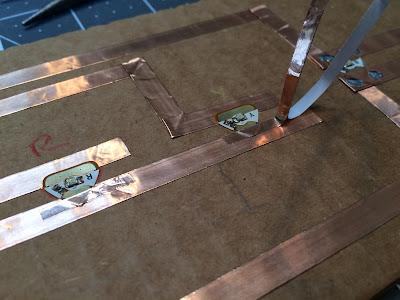My second project with a Chibitronics Love to Code (LtC) prototype board was the completion of a project I had been sitting on for a while. Back when I was programming Turtle Blocks to produce tools to help me create complex work, I 3D printed a template that I used to help me cut mat board in a geometric pattern.
I decided to build an array of programmable lights behind the shapes to illuminate them in patterns. First, I cut a piece of cardboard the same size as the cut mat board and labeled which color LED I wanted in each space. I marked where the LEDs and circuits would go on the cardboard.
I built circuits from three of the "pins" and the ground on the LtC board using conductive copper tape. In places where the copper tape had to cross other circuits I insulated the copper tape with scotch tape.
The Chibitronic LED stickers were placed on the copper tape circuits, covered with more copper tape, then soldered.
With everything in place the circuits were tested. A sketch that turned the three pins on was loaded onto the LtC board and run.
I used vellum between the circuits and the mat board. The vellum is taped to the mat board at the top and the bottom. The vellum diffuses the LED light.
I used hot glue to attach two square wood dowels to the circuit board to offset it from the mat board and vellum.
The current sketch loaded on the board cycles through blue, yellow, then red LEDs. (My wife just informed me she cannot handle the way the lights turn on and off, so I will be changing the sketch soon haha!).
I soldered an Adafruit PowerBoost Basic to the LtC 3-6V pin and the ground pad.
The PowerBoost has a power switch connected to it as well as a 500mAh lipo battery. This makes the artwork rechargeable.
The person who framed the piece backed it with two pieces of foamcore. I cut recesses in the outer piece and used double-sided tape to affix the PowerBoost and the battery to the back of the piece so it can hang on the wall.
The final piece drives my wife crazy but, she admits, is beautiful. It will be a good challenge to write a different sketch that is more pleasing for both of us.
Perhaps that is the most amazing part of this electronic art: it can be reprogrammed to change the patterns, making it completely dynamic, truly interactive, and aesthetically personalized!
Full disclosure: I was provided the Chibitronics LtC prototype board for evaluation and use in my projects but was not otherwise compensated nor told what to produce.
































Comments